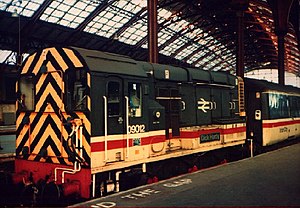British Rail Class 09

09012 at Brighton station
|
|||||||||||||||||||||||||||||||||||||||
|
|||||||||||||||||||||||||||||||||||||||
|
|||||||||||||||||||||||||||||||||||||||
|
|||||||||||||||||||||||||||||||||||||||
|
|||||||||||||||||||||||||||||||||||||||
| Type and origin | |
|---|---|
| Power type | Diesel-electric |
| Builder | British Railways' Darlington Works, Horwich Works |
| Build date | 1959, 1961-1962 (09/0) |
| Total produced | 26 (09/0) |
| Rebuild date | 1992-1993 (09/1, 09/2) |
| Number rebuilt | 12 (7 09/1 + 5 09/2) |
| Specifications | |
|---|---|
| Configuration: |
|
| • Whyte | 0-6-0 |
| • UIC | C |
| Gauge | 4 ft 8 1⁄2 in (1,435 mm) standard gauge |
| Wheel diameter | 4 ft 6 in (1.372 m) |
| Minimum curve | 3.5 chains (70.41 m) |
| Wheelbase | 11 ft 6 in (3.505 m) |
| Length | 29 ft 3 in (8.92 m) |
| Width | 8 ft 6 in (2.591 m) |
| Height | 12 ft 8 1⁄2 in (3.874 m) |
| Loco weight | 49 long tons (49.8 t; 54.9 short tons) |
| Fuel capacity | 668 imp gal (3,040 l; 802 US gal) |
| Prime mover | English Electric 6KT |
| Generator | DC English Electric 801 |
| Traction motors | 2 x English Electric 506 |
| Transmission | Diesel-electric, double reduction gearing |
| Train heating | None |
| Train brakes | originally Vacuum, later Dual, some now Air only |
| Performance figures | |
|---|---|
| Maximum speed | 27.5 mph (44.3 km/h) |
| Power output | Engine: 350 hp (261 kW) |
| Tractive effort |
Maximum: 25,000 lbf (111.2 kN) Continuous: 8,800 lbf (39.1 kN) |
| Brakeforce | 19 long tons-force (189 kN) |
| Career | |
|---|---|
| Operators | British Rail |
| Number in class | 38 |
| Numbers |
09/0: D3665–D3671, D3719–D3721, D4099–D4114; later 09001–09026 09/1: 09101-09107, 09/2: 09201-09205 |
| Axle load class | RA 5 |
The British Rail Class 09 is a class of 0-6-0 diesel locomotive designed primarily for shunting and also short distance freight trips along branch lines.
The 26 locos are similar to the Class 08 shunting locomotives but have different gearing, giving a top speed of 27.5 mph (44 km/h) at the expense of a lower tractive effort. They were introduced from 1959 to 1962 and latterly operated in the Southern Region of British Railways, although some of the class were originally allocated to depots in the Midlands and North before transferring south. Further locomotives were converted from Class 08 in 1992 and, following this and privatisation in 1997, the class has been distributed much further afield.
The original 26 locomotives (built 1959-1962) became sub-class 09/0 when further locomotives were modified from Class 08 in 1992 which became subclasses Classes 09/1 and 09/2. There were variations, which were given the following TOPS design codes:
These locomotives were modified from Class 08 in 1992. TOPS numbers were 09 101 – 09 107 and 09 201 – 09 205. The design codes were as follows:
Although not normally considered for passenger work, Class 09s were recorded working passenger trains between Clapham Junction and Kensington Olympia due to unavailability of the booked Class 33 diesel.
They were also used on Railtours which needed to depart Brighton heading along the West Coastway Line or vice versa. To achieve this the 09 worked between Brighton and Preston Park, allowing main tour locomotive to work the train forward via the Cliftonville tunnel and Hove. The connection to the West Coastway Line at Brighton can only be used by four car trains due to the arrangement of the points and track.
...
Wikipedia
